This is I think my penultimate post about the Moto Hagio’s collection of stories A Drunken Dream. You can read the whole series here.
_________________
Drunken Dream concludes with two entirely forgettable sentimental ghost stories: “The Child Who Comes Home” and “The Willow Tree.” Both exploit familial grief — respectively, dead child and dead mother — and an emotional twist-ending in the service of tear-jerking emotional catharsis. Unfortunately, as has been a problem before in this volume, Hagio has neither the space nor the inclination in these stories to create fully realized characters, and so the grief and pathos come across as both generic and unearned. These are probably the dullest stories in the volume. Some of Hagio’s work is actively stupid and irritating , but these really feel like she’s just filling the form in. Ambiguous death, twist, catharsis. That’s a wrap.
So yeah; not a lot to say. Except…I’ve been thinking a little about feminist film gaze theory and how it would work in comics. So I’m going to try to read “The Willow” through Laura Mulvey’s classic 1975 essay “Visual Pleasure and Narrative Cinema” and see what happens. Maybe it’ll even get me to like the story better; who knows?
______________
Mulvey’s essay is based in Lacanian and Freudian theory. I’ll quote from second paragraph.
The paradox of phallocentrism in all its manifestations is that it depends on the image of the castrated woman to give order and meaning to its world. An idea of woman stands as lynch pin to the system: it is her lack that produces the phallus as a symbolic presence, it is her desire to make good the lack that the phallus signifies….. To summarise briefly: the function of woman in forming the patriarchal unconscious is two-fold, she first symbolises the castration threat by her real absence of a penis and second thereby raises her child into the symbolic. Once this has been achieved, her meaning in the process is at an end, it does not last into the world of law and language except as a memory which oscillates between memory of maternal plenitude and memory of lack. Both are posited on nature…. Woman’s desire is subjected to her image as bearer of the bleeding wound, she can exist only in relation to castration and cannot transcend it. She turns her child into the signifier of her own desire to possess a penis (the condition, she imagines, of entry into the symbolic.) Either she must gracefully give way to the word, the Name of the Father and the Law, or else struggle to keep her child down with her in the half-light of the imaginary. Woman then stands in patriarchal culture as signifier for the male other, bound by a symbolic order in which man can live out his phantasies and obsessions through linguistic command by imposing them on the silent image of woman still tied to her place as bearer of meaning, not maker of meaning.
So to summarize the summary (as much for my benefit as anyone else’s): woman=castration. This symbolic difference is the basis for symbolization itself; it’s the difference that enables or creates meaning. Woman exists only to embody this difference; she is the non-meaning (castration) which enables meaning (the phallic father’s realm of law and language.) Woman cannot take up the law and language herself; she can attain mastery only vicariously through a child who acts as a substitute phallus. (Ideally, the woman will give this phallus up to the world of law; alternately she may try to retain it, preventing it from entering adulthood and the world of law.) The phallic law rules, and what it rules or regulates is non-meaning/castration/woman. Woman is then by definition silent and controlled.
Maybe this is clear already, but I should emphasize that Mulvey does not think this narrative is true. She’s saying it describes the way power and desire by society, not biology. Lacan and Freud thought they were describing nature; Mulvey says they’re describing (phallocentric) culture.
So that’s Mulvey. Now for Hagio’s “The Willow Tree” The story shows a woman with an umbrella standing beside a willow tree over a period of years (you see the tree growing.) In the background, you see a series of images from the life of a boy — he has a fight with kids at school, gets a girlfriend, has a child of his own, etc. The woman by the tree watches the boy until he is an adult. Then he finally comes down to the tree to speak to her. Uttering the first words of the story, he says he forgives her for leaving him, acknowledges that she has been watching him the entire time, and calls her “mother”, at which point she disappears (cause she’s a ghost, duh) and he leans his head on the tree.
How does Lacan fit “The Willow Tree”? With uncanny precision, actually. In the first place, as I said, the whole story is organized around looking at a woman standing next to a phallic symbol.
Castration and phallus — they go together!
The woman is clearly, as Mulvey says, locked “In the half-light of the imaginary,” living out a twilight existence in which she clings to the phallus/hangs on the doings of her son (who is the phallus.) Since she is outside the symbolic, she cannot speak. Instead, it is the son who eventually addresses her, acknowledging the necessity by which she left him in order to push him out into the world of law and language. His memory of her again fits neatly with Mulvey — on the one hand he says he resents how she “disappeared from my life so suddenly,” a split that suggests castration. On the other hand, he knows she has “been watching me all along,” through a mystical, imaginary plenitude. Holding the mixed, verbalized memory of severance and fullness, he now controls her, and so as a separate person, she disappears. He ends by embracing not his mother, but the phallus. Adulthood has its roots in the mother, but she is not part of it.
Mulvey suggests that, in cinema, real women are turned into symbolic willow trees mainly through the function of the gaze. There are, for Mulvey, two kinds of gaze, or scopophilia (pleasure in looking.) The first is voyeuristic. Mulvey notes:
Frued isolated scopophilia as one of the component instincts of sexuality which exist as drives quite independently of the erotogenic zones. At his point he associated scopophilia with taking other people as objects, subjecting them to a controlling and curious gaze.
Mulvey also associates this kind of voyeurism with sadism, i.e with controlling others and treating them as objects.
The second pleasurable gaze is narcissistic. Mulvey associates it with Lacan’s mirror stage; the moment when the child recognizes itself in the mirror.
The mirror phase occurs at a time when the child’s physical ambitions outstrip his motor capacity, with the result that hsi recognition of himself is joyous in that he imagines his mirror image to be more complete, more perfect than he experiences his own body. Recognition is thus overlaid with mis-recognition: the image recognised is conceived as the reflected body of the self, but its misrecognition as superior projects this body outside itself as an ideal ego…
Mulvey says the cinema function like a mirror in allowing “temporary loss of ego while simultaneously reinforcing the ego.
For Mulvey the voyeuristic gaze and the narcissistic gaze are both vitally important in narrative cinema — and they both are structured around gender. Specifically, the cinema for Mulvey figures men as the gazer (active) and women as the gazed upon (passive).
Mulvey suggests (she doesn’t quite say this, but I think it’s the implication) that the two different kind of gazes create a productive tension in narrative film. On the one hand, the voyeuristic gaze is directed at women, who are eroticized and displayed “with their appearance coded for strong visual and erotic impact so that they can be said to connote to-be-looked-at-ness.” The looked-upon woman’s body, then, tends to “freeze the flow of action in moments of erotic contemplation” — it works to focus on the frozen image rather than the moving narrative.
The narcissistic gaze, on the other hand, is aimed at males; the screen heroes who are both identified with and more powerful than the viewer. “A male movie star’s glamourous characteristics are thus not those of te erotic object of the gaze, but those of the more perfect, more complete, more powerful ideal ego conceived in the original moment of recognition in front of the mirror.” It is these characters who drive the narrative; who make things happen. Men are narrative (linguistic) women are silent, and this dichotomy is created and eroticized through the mechanism of the gaze.
Again, for Mulvey these two kind of gazes are in narrative tension in cinema; you can’t both stare voyeuristically at a pretty women and follow a narrative at the same time; in narrative cinema, you’re doing one or the other. But comics, as it turns out, gives you some other options:
Hagio throughout “The Willow Tree” gives us the pretty woman in the foreground and, in the back at the top of the hill, the narrative action of the child growing through time (or getting in a scrape in the bottom panel.)
This suggests that the dichotomy between narrative and eroticized image is not as stark in comics as in narrative cinema. Comics are still images, after all; the body is always frozen for display at the same time as it takes part in the sequence of narrative. Thus, all bodies in a comic may be eroticized — male as well as female. And indeed, the historically dominant narrative form in Western comics intensely eroticizes muscled, betighted male bodies as a matter of course (though Mulvey may downplay the role of male homoeroticism in cinema as well.)
Most discussions of Mulvey focus on “the male gaze” and the way that visuals are designed to cater to men’s voyeuristic and narcissistic desires. Moto Hagio’s stories are intended for a primarily female audience; the subject of the gaze her is a woman, not a man. But if, as I’m suggesting, voyeurism and narcissism are more fluid in comics, the gender of the viewer may be less important to the mechanism of the gaze. In particular, the frozenness of the image and its participation in narrative means that the object of the voyeuristic gaze can also be the subject of the narcissistic gaze and vice-versa. Or, in other words, in comics, readers of all genders can, with relative ease, objectify and identify with characters of all genders. In this reading, comics are more polymorphously perverse — less controlled — than film.
Thus, in “The Willow Tree”, aimed at a female audience, the mother is the object of the gaze. She’s not overtly sexualized — but she is (which I think is actually more important for Mulvey) made to connote “to-be-looked-at-ness.” With her wide eyes and trimly pretty dress and parasol, striking poses as if in a photograph, she is almost doll-like; designed to be stared at, admired, and loved — in short, eroticized.
But the mother is also, and constantly, the main object of identification. She’s closer to us, more visible…and perhaps most importantly, placed in our position. She is watching as we are watching — a surrogate viewer. If we identify with the child being watched, it’s through her interest and delight. She, like us, is the fixed eye; the child comes and goes for her.
Mulvey argues that the way around the gendered gaze of narrative cinema is to fracture narrative; she doesn’t go into too many specifics, but she basically seems to be calling for/encouraging the avante garde as a feminist alternative to Hollywood. Moto Hagio, on the other hand, seems to be using the potential of the comics form — the easy conflation of voyeuristic and narcissistic gazes, the polymorphous perversity — to create a feminine (if not a feminist) narrative. Pushing the narrative (literally) to the margin, Hagio builds her tale around voyeuristic narcissism, or narcissistic voyeurism — the pleasure of watching one’s mirror image watching.
Moreover, the male object of the gaze of the female object of the gaze is itself, finally, eroticized for voyeuristic pleasure…and also treated as the narcissistic object of identification. Male and female are thus both looked-at and looking; the parallels between the two emphasized by their position on a single page:
p.252
Both son and mother look out at the reader, who is looking at them each in turn. They are both aestheticized — through the giant eyes, the wisps of willow branches — and they are both objects of identification, charged, through the very intensity of their stares, with an emotion that we are supposed to share. If Mulvey’s cinematic gaze manufactures gender distinctions through the process of its unspooling, Hagio’s manga gaze flattens those same distinction upon the stillness of the page.
This perhaps points to an explanation for yaoi which is formal as well as sociological. The eroticization of male bodies for a female audience is enabled not solely by Japanese history, but also by the ease with which the gaze in comics transfers from voyeuristic to narcissistic and back. Since the stillness of voyeurism and the movement of narcissism are always simultaneously present in each comics image, gendered eroticism and identification are potentially more labile than in cinema. Perhaps, too, that’s why the form appealed so much to a creator as interested in gender fluidity as Hagio.
Those are all fairly tentative conclusions…but did it all help me appreciate Hagio’s story more?
Well, not exactly. “The Willow Tree” still sucks.
I guess I have more appreciation for the formal deftness with which Hagio provides her readers with a shifting back and forth between voyeurism and identification. And the idea of the comics gaze as polymorphously perverse seems like it would be interesting to explore in relation to some of Hagio’s other, better stories.
But in this story, the fact that we have a female viewer and a polymorphous gaze still leaves us sitting under the same damn tree. Giving the woman the gaze doesn’t give her speech or power or options — instead, it purports to replace them. The woman has nothing of her own, only the vision of the life of another. This is the same old, tired story of the mother who gives birth to her own phallus…and then gives that phallus her life. Hagio makes the son’s story marginal so we can empathize with the mother empathizing…but that empathy only emphasizes (and sentimentalizes) the emptiness of her existence; the lack that is her core.
In the end, the surprise twist is that it was the boy’s story all along. The pleasure here is the pleasure of perversely gazing at one’s own eroticized disempowerment. In short, “The Willow Tree” is both tediously familiar and morally bankrupt. As Laura Mulvey put it, “It is said that analysing pleasure, or beauty, destroys it. That is the intention of this article.” Preach it.
___________________
After finishing this essay, I started to read Anne Allison’s Permitted and Prohibited Desires: Mothers, Comics, and Censorship in Japan. On the one hand, Allison helps put the Lacanian dynamic discussed here in specific cultural context: Allison argues that mothers in Japan of the 1980s (and presumably later, when I think this story was released) are expected to ensure “that their children are working hard enough to realize their performative potential” on the all-important academic tests which determine future career prospects. Women, Allison says, “suture home and motherhood to the very regime of a child’s performativity, insisting that performance continue, even intensify, on familial turf.” Thus, women are intimately tied to attainment of social mastery, in which they themselves cannot (due to systemic discrimination) participate.
On the other hand, though, Allison argues that Lacan doesn’t work in certain ways when applied to Japanese culture. Specifically, she says that the importance of mothers, and the absence of fathers (always working) in Japanese households means that the sharp break with motherhood (castration) and the consequent emphasis on the phallus doesn’t work when talking about Japan. Instead, Allison argues, Japanese development is characterized not by rejecting the mother, but by recognizing that she is not omnipotent, overcoming that anger, and reconciling with her in order, not to become an individual, but to take one’s place in a social network.
You can see that working here; the son expresses his initial anger,and his final acceptance of the mother. But…this story also imagines a violent, early break with the mother, a developmental pattern that (Allison suggests) is more Western. And there’s the mother’s enforced silence. And that darn phallic tree.
Perhaps the way to reconcile this is to point out that Hagio herself is clearly, throughout her work, very uncomfortable with the kind of non-Oedipal, reconciled society that Allison sees as typically Japanese. Hagio, you might say, sees in herself and her society a lack, and that lack is the Oedipal conflict itself. In this reading, the Lacanian, western narrative of castration leading to individuality could be seen as a kind of fantasy/escape from the Japanese psychosexual narrative of reconciliation and consent. You can see her perhaps tyring to work this out in Iguana Girl where reconciliation with the mother is tied to the achievement of individuality, and both are predicated on the mother’s removal through death.
Similarly, in “The Willow Tree”, the switch at the end, where we see this as the son’s story, could be Hagio tipping her hand; it’s the child she’s interested in, not the mother. She wants the phallus, and to get it, the mother has to die. The ambivalent self-hatred worked out as misogyny, the demand for independence displaced and covered in sentimentality and guilt — they’re both familiar themes by the end of this volume. In the Japanese context, Hagio’s dreams of castration may in fact be an act of rebellion. Sometimes, that contradiction fills her work with bizarre, evocative spaces, flashes of pain and revelation. And, sometimes, as here, she subsumes the tensions through rote capitulation to genre and cliche, tidily resolving the problems caused by women who don’t want to or can’t conform to gender expectations by killing them off and then having a satisfying cry on their graves.
_________
I’m done with all the stories in the volume now, but I hope to write one more article talking about the criticism that has been written about the book.

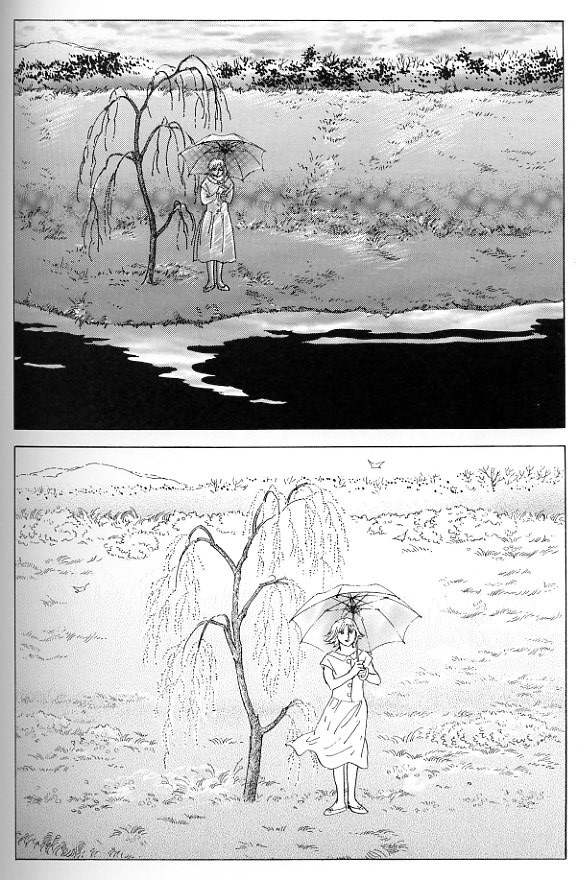
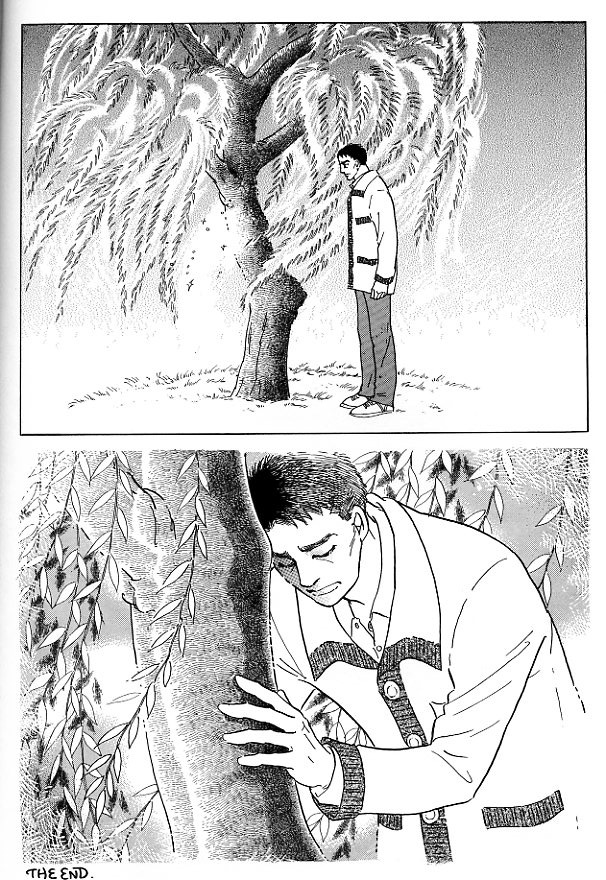
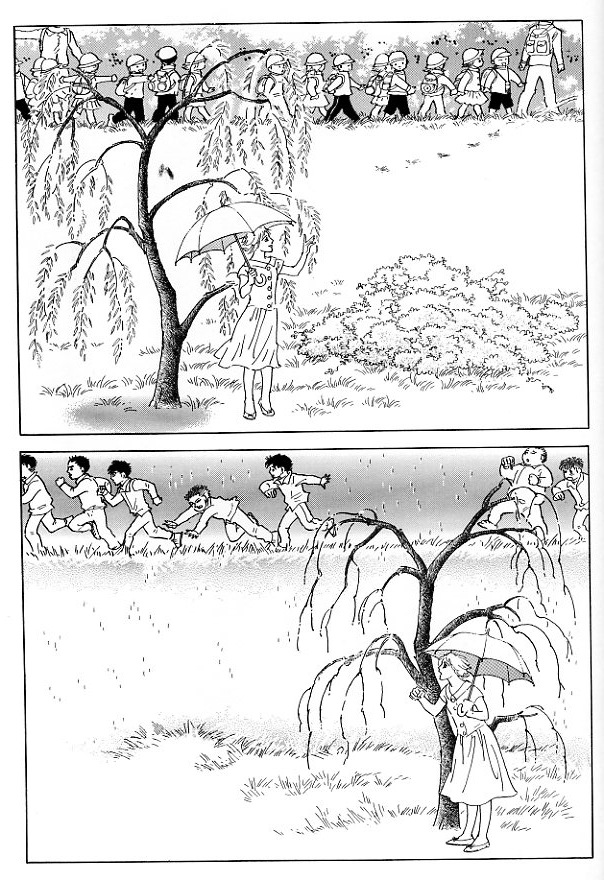
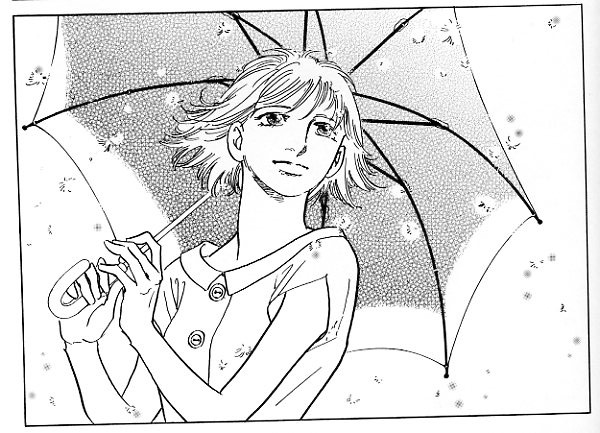
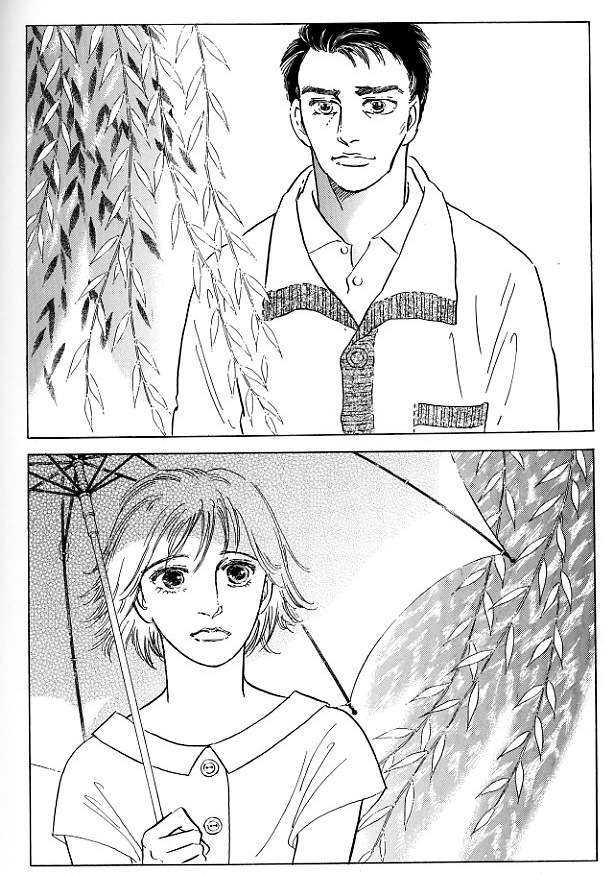
“Thus, women are intimately tied to attainment of social mastery, in which they themselves cannot (due to systemic discrimination) participate.”
And does this work in a society which is seeing its women delaying marriage (adopting singlehood in many instances) and child bearing so as to preserve their independence?
“Japanese development is characterized not by rejecting the mother, but by recognizing that she is not omnipotent, overcoming that anger, and reconciling with her in order, not to become an individual, but to take one’s place in a social network.”
This sounds like a theory designed to explain the *perceived* conformity of the Japanese people. I can see this kind of thing being badly applied to the Chinese people as well (though it does nothing for the intense “rebelliousness” of the Taiwanese and Koreans). The presence of a residual Confucian ethic might be more useful in this instance.
I think it would be more helpful to see “The Willow Tree” as a descendant of a number of somewhat sentimental Asian tales extolling the power of a mother’s love. I can’t come up with any names on the spur of the moment but I do remember at least one movie where the mother in question is a “fallen” woman (a prostitute; a kind of societal phantom/pariah). You can imagine how the plot works out. I think you’ll find a very similar dynamic at work in Mori Ogai’s Sansho the Bailiff (made into a very famous and depressing movie by Mizoguchi). Note what happens to the sister and mother in that story.
It is tricky. The adaptation of Freudian theory to Japan in terms of reconciliation rather than rupture was originally propounded by Kosawa Heisaku, the founder of psychoanalysis in Japan. Freud rejected his theories on the basis that psychoanalysis was universally applicable, regardless of cultural variance. (All this according to Allison.)
I presume the prolongation of singlehood your discussing is in contemporary Japan? Allison makes a good case that there remained systemic discrimination and a powerful ethic of motherhood in the Japan of the 80s, at least. Things could have changed a good bit since then, obviously. In terms of the U.S., I think the dynamic Lacan discusses has become less omnipresent over time, certainly — though I don’t think it’s completely irrelevant still.
Whether or not Japan is actually stiflingly conformist, I think there’s little doubt that it is often presented as such in Hagio’s work (much as Southern black society is presented as stiflingly conformist in Richard Wright’s work, or small town society as stiflingly conformist in Sinclair Lewis.)
I think Allison would probably argue that the centrality of stories extolling a mother’s love in this way can be, or could be linked to some of the psychoanalytic dynamics I’m talking about here. Having said that…it would be great to see a discussion of Hagio’s work in the context of other similar work, in both comics and film.
“Whether or not Japan is actually stiflingly conformist, I think there’s little doubt that it is often presented as such in Hagio’s work (much as Southern black society is presented as stiflingly conformist in Richard Wright’s work, or small town society as stiflingly conformist in Sinclair Lewis.)”
Are you implying that “The Willow Tree” (a relatively recent story) is hopelessly dated? I would probably agree with that. She has that in common with Eisner and his “mature” graphic novels. Adds to the sentimentality as well – big market for that.
Yeah; I”m not sure when The Willow Tree is from — but it’s the last story in the book, and it’s listed as 2007 pub date (which I think is probably when it was collected rather than first published.) But I’d say it certainly feels old; I mean, in a Western context the sentimentality feels positively Victorian. And her visual style dates it pretty thoroughly anyway, doesn’t it?
I don’t know that the tensions around good mothers/bad mothers, conformity, and reconciliation are themselves entirely out-of-date in terms of Japan though. Similar themes show up in Paradise Kiss, for example…and somewhat in Nana too…. It’d be interesting to have somebody with a better handle on contemporary shojo chime in….
It’s funny; you’re dinging me for emphasizing the conformity of Japanese society…and also for treating Hagio’s work as the product of her own individual sensibility rather than as purely a genre exercise. Not that either of those are illegitimate, or even really contradictory — I’m more admiring the horns of the dilemma….
Suat,
“I do remember at least one movie where the mother in question is a “fallen” woman (a prostitute; a kind of societal phantom/pariah)”
Imamura’s _Insect Woman_?
Not that one. That’s a bit too serious and commendable. I was thinking of much more commercial fare like the Andy Lau movie called, The Truth – “orphan” son defends mother (“old prostitute”) in a murder case. Big sentimental hit in Asia. I think Hagio’s story, while not directly influenced, probably comes from the same lineage as films like that. There is some “individual sensibility” in “The Willow Tree”, largely emanating from the fixed perspective afforded by the comics short story form as well as the symbolic/graphical distance breached in the final panels. But neither of these are particularly novel as far as Western comics are concerned, and the overall tone is very familiar. The Imamura and Ogai/Mizoguchi stories are more concerned (and critical) about place of women in society.
I don’t think the post disagrees with any of that, does it? I was trying to say that I think it demonstrates Hagio’s concerns, but that she (in this case) largely tries to resolve them by capitulating to genre (and I think to traditional gender roles) in a way I find quite tedious. But maybe that didn’t come through clearly enough….
Noah, you had to have picked that lead image for a reason, right? That’s the most feminine, mountable drawing of a tree I’ve ever seen. Shel Silverstein notwithstanding, there’s never been a more giving tree. Talk about junk in the trunk! I’ll be here all week!